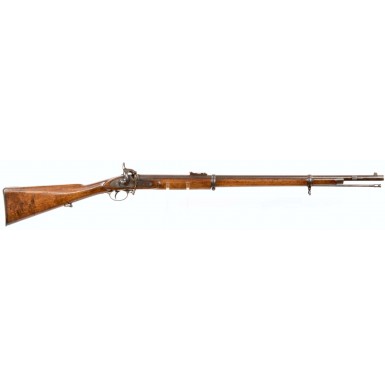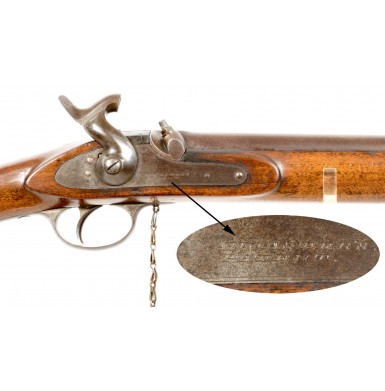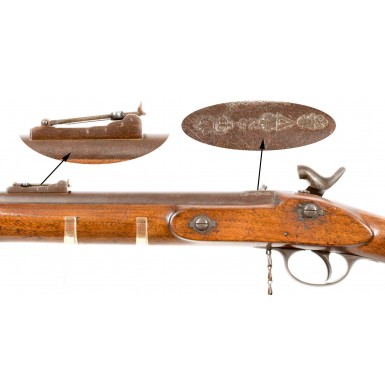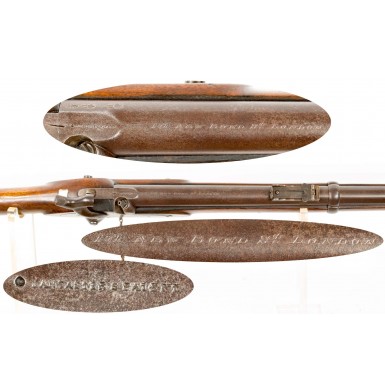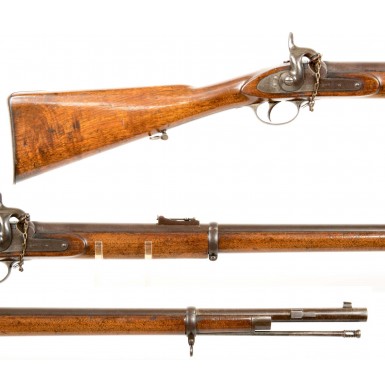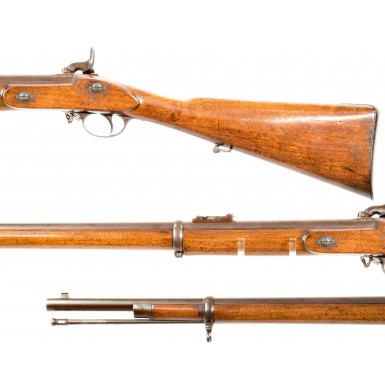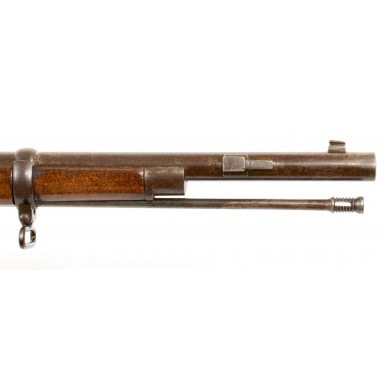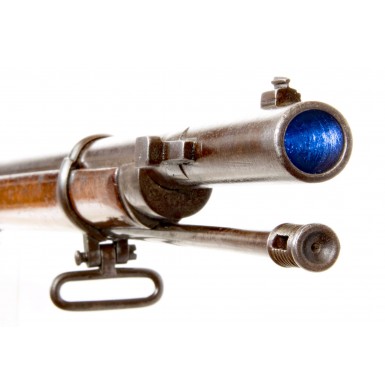British Lancaster's Patent Oval Bore "Sappers & Miners Carbine"
- Product Code: FLA-3574-SOLD
- Availability: Out Of Stock
-
$1.00
In January of 1852, the British Board of Ordnance began taking the first tentative steps towards designing what would eventually become the Pattern 1853 Enfield Rifle Musket. These movements were not without some hesitancy, as the Pattern 1851 Minié Rifle had been officially adopted only the previous year, and arms were just starting to be delivered by the contractors. Even though the P1851 was the first rifled arm for general issue to the British military, officially ending the era of the smoothbore musket in English service, it was a design that was obsolete prior to its adoption. The large, .708” caliber was an anachronism of a by gone age, and various Continental armies had been experimenting and even issuing smaller bore rifled arms since the latter part of the previous decade. It was this knowledge that a smaller bore rifle musket was necessary in order to stay competitive with the armies of Europe that spurred the Board of Ordnance to start experimenting with “small bore” rifles.
The first two trials rifles to test the basic theory of a reduced caliber, elongated bullet design were ordered to be set up at the Royal Small Arms Factory at Enfield Lock (R.S.A.F.) in January of 1851 and were for all practical purposed simply smaller bore pattern 1851 Minié Rifles. However, these guns were only intended to demonstrate to the English military what had already been proven on the European continent; the “big bore” military musket was dead and the “small bore” rifled musket was the new heir apparent to the throne of infantry small arms. At that time, the Royal Small Arms Factory at Enfield was not the thriving manufactory that America’s Springfield or Harper’s Ferry arsenals were, and the arms produced there were made essentially by hand from a mixture of government made and contractor delivered parts in much the same manner as the Brown Bess muskets had been “set up” at the Tower of London nearly two centuries earlier. It would not be until 1856, in the wake of the Crimean War, that the R.S.A.F. would be modernized and outfitted with machinery from America, allowing it to operate on the “American System” of manufacture; using interchangeable parts on an assembly line. As a result, the design of what would become the Pattern 1853 Enfield was in some respects left up to the powerhouses of the British arm manufacturing community, namely Westley Richards, Charles William Lancaster, James Purdey, Henry Wilkinson and W.W. Greener; all of whom are household names to any student of English arms from the period.
As Dr. C.H. Roads so artfully puts it in his seminal book on the subject The British Soldier’s Firearm - From Smoothbore to Smallbore 1850-1864: “…all agreed to construct and submit the best military rifles their ingenuity could fashion.”
The arms submitted by these makers took a variety of designs and provided the Board of Ordnance the ability to further investigate such technical nuances as types of rifling, as well as rates of rifling twists, patterns of rear sights, bullet designs, etc. As a sort of “control” these trial arms were often compared with known quantities like the Pattern 1851 Minié Rifle and the Brunswick Rifle, and at times special versions of these current issue rifles (usually only one or two) were produced at Enfield to test a specific design principle, while leaving all other factors constant. An example being the reduced bore P1851s produced in January in of that year in .635” caliber versus the standard .708”, to test the basic principle of a smaller bore diameter. The submissions by the various makers were all different calibers and with different patterns of rifling and each used a bullet of their own design, with only constant that the bullet weight was to be about one ounce, a weight considered the minimum for an effective infantry musket.
Lancaster’s submission was his “oval bore” design. This was a mechanical rifling system that from all appearances was a smoothbore design. However, the bore was very slightly oval in cross-section with a minor axis of .543” and a major axis of .557” at the breech, which was slightly reduced to .540” and .55” at the muzzle. The bore itself twisted along the length of the barrel, creating mechanical rifling similar to the systems that would be subsequently patented by Sir Joseph Whitworth and Westley Richards. The pitch of the riling also increased along the length of the bore, in other words the rifling spun slower at the breech and more quickly at the muzzle. The oval bore rifling performed very well in the trials, as did the five-groove design of Wilkinson and the 3-groove design submitted by Enfield. These experimentations resulted in what would become the basic design specifications for the Pattern 1853 Enfield Rifle musket: a 39” barrel secured by three barrel bands, with a .577” bore, rifled with 3-grooves with a 1:78 rate of twist, weighing in at slightly more than 9 pounds including the socket bayonet, which would incorporate a locking ring. It was further specified that the lock would include a “swivel” (stirrup) so that the mainspring did not bear directly upon the tumbler as it did in earlier designs. The specification regarding a rear sight remained somewhat open to discussion, as a number of designs had been submitted, several of which were quite good. Interestingly the rifling pattern was not completely established either, for although the initial specifications called for the three groove bore of Enfield design, the performance of the Lancaster and Wilkinson pattern rifling left significant doubt in the minds of the Small Arms Committee as to whether the correct decision had been taken as to the style of rifling to be use. A bullet design, which was a collaboration of William Pritchett and William Metford, was adopted for use in the nominally .577 bores of the guns.
In January of 1853, an order for 1,000 of these newly specified rifle muskets, 500 with one pattern or rear sight and 500 with another, was placed, in order to begin real field trials of the weapon. In the end the sight designed by Charles Lancaster became the rear sight that we are familiar with on the Pattern 1853 Enfield today. The result of the committee’s lack of confidence that they had “chosen wisely” regarding the rifling system was readily apparent in early 1853, when Wilkinson and Lancaster were both asked to submit Pattern 1853 Enfield Rifle Muskets that conformed exactly to the pattern as was newly adopted, with the only exception being the rifling of the bores, which were to be of the two makers’ patent designs. In June of 1853, the trials of the three rifling systems began and the Lancaster oval bore shot better than either of its competitors. Initially, Lancaster asked to have his guns fired with his own cartridges that used specially sifted powder. However, it was soon discovered that the standard British military service load with standard service powder and the 530 grain Metford-Pritchett bullet shot better in the Lancaster gun than his own specially designed cartridge! Wilkinson insisted on using his own proprietary cartridge as well and did not acquiesce to the use of the standard service load during testing. The result of testing the three systems at 500 yards, aimed at a 6’ foot target resulted in the Lancaster rifling system placing all shots in a 4’ group, while the Enfield rifling could only keep 75% of the shots on target at that distance. The Wilkinson system fared far worse, failing to reliably keep shots on the 6’ target at 200 yards! The results of the testing were so promising that an additional 20 oval bore P1853s were ordered from Lancaster for further evaluation by the Committee on Small Arms. In addition, it was decided to issue the available 3-groove P1853s very sparingly, in the event that Lancaster’s system was eventually adopted over the Enfield 3-groove bore. To further indicate that the decision was not yet set in stone, it was ordered that all P1853s in the production pipeline (some 20,000 contract arms) be made smoothbore, pending the final decision regarding the rifling pattern. The additional testing in August of 1853, shooting at distances of up to 800 yards, again showed the superior accuracy of the Lancaster design. However, two issues had raised concerns among the nay-sayers who supported the Enfield pattern rifling. The first was that the increasing spiral of the bore was complicated and difficult to produce, which would make it harder for the various arms contractors (as well as R.S.A.F.) to manufacture the Lancaster patent barrels. The second concern was that the relief at the breech, being slightly larger than the muzzle, could allow a loaded bullet to move forward when the arm was in service, leaving an air gap between the bullet and the powder charge. It was feared that this gap might create an unsafe situation resulting in increased pressures and a burst breech when the gun was fired. Lancaster subsequently performed tests with bullets that were not fully seated, which proved that this fear was unwarranted. However unfounded, the concern would affect further testing of the Lancaster system and in some ways conspired to help it fail.
In late August, five trial P1853 Enfields were set up at Enfield with Enfield made, Lancaster patent barrels. The barrels had a minor axis of .577” and a major axis of .587” and has the standard 1:78” rifling pitch. The barrels did not have the breech relief of the Lancaster made barrels, nor did they use progressive twist rifling, so the rate of twist remained constant through the length of the bore. These five rifles were tested against Lancaster’s submissions and were found to be sorely lacking, with the Lancaster produced rifles placing 99 of 100 rounds in a reasonable group on a 300-yard target, and the Enfield produced oval bores missing the target entirely 68 times at the same distance! Amazingly, this additional confirmation only resulted in additional testing, with the Board of Ordnance’s decision making process moving with all the speed of a receding polar ice cap! This fourth series of tests of the Lancaster system in 1853 again proved that the oval bore rifling was superior not only to the conventional 3-groove rifling employed at Enfield, but also to the Enfield made version of the oval bore. In these tests, the Enfield “oval bore” showed a tendency to “strip” after a significant amount of firing, what a modern shooter would refer to as the bore being “shot out”, with the rifling being worn beyond the point of serving its purpose. While the Lancaster made rifles did not show this tendency, it was implied that since this defect existed in the Enfield made arms, that “production quality” oval bore rifles, not produced with the same precision as Lancaster’s trial rifles, would suffer the same fate. Thus, a fifth set of tests were performed in November 1853, this time eliminating the Enfield made oval bores and once again putting the Lancaster oval bore in a head-to-head competition with the 3-groove Enfield. This last series of tests for 1853 showed that even Lancaster’s well-made guns, after a significant amount of firing, began to “strip” as the Enfield made versions had. The report noted that no visible (or even measurable) deterioration was noted, but that after repeated firing the accuracy of the guns gradually eroded. It appears that the Small Arms Committee was performing the tests with the same five trials rifles that had been supplied that summer, and it was likely at this point that thousands of rounds had been fired through the guns. Amazingly, this report resulted in a new series of tests in early 1854. This sixth test required more than 1,000 rounds to be fired from a single Lancaster oval bore rifle musket versus a standard Enfield P1853. As had been discovered in the final testing at the end of the previous year, the Lancaster system began to “strip” and the accuracy degraded over time. The reason for the failure could not be discovered, and as the oval bore system was so much more accurate than the 3-groove system when the bore was new, the supporters of Lancaster’s design lobbied for another test (the seventh) in February of 1854, with the results being the same. At this point, it appears that serious pursuit of the Lancaster rifling system by the Small Arms Committee was abandoned. However, only a year later, Lancaster’s design was adopted for limited production and issue to the Royal Engineer Corps, as the Pattern 1855 Royal Engineer’s Carbine, or more commonly as the Royal Sappers & Miners Carbine, with Lancaster’s Oval Bore. So, as we can see the oval bore concept was far from dead and still had several supporters with the small arms and ordnance communities.
In a continuing attempt to try to improve upon the basic design of the Pattern 1853 Enfield rifle musket, various trials continued at the School of Musketry at Hythe, under the direction of Colonel Hay, the commander. Very often these trials involved only one or two experimental examples of an arm, set up at Enfield for the express purpose of testing a specific theory about the performance of one particular feature. The testing performed by Colonel Hay resulted in several recommendations regarding the current service pattern Enfield rifle musket. These recommendations included reducing the length of the butt by 1” to change the length of pull from 14” to 13”, changing the location of the rear sight to improve the ability of a solider to easily focus upon it, changing the number of grooves in the rifling from three to five and changing the rate of twist from 1:78” to a much faster 1:48”. Many of these suggestions were never adopted for the Pattern 1853 Enfield in service, although the length of pull was eventually shortened, but were adopted for use in subsequent versions of the Enfield “short rifle” and were also incorporated into Colonel Hay’s “Hay Pattern” Enfield or “Medium Enfield” design. While the Hay Pattern was never officially adopted by the Board of Ordnance, it was a popular design for military match target shooters and saw reasonably successful sales to the New Zealand military. It appears that during 1856, after the adoption of the Lancaster Patent rifle for use by the Royal Engineers, that Colonel Hay required that two P1853s be set up at Enfield with the Lancaster oval bore to test the effects of fouling upon the design, versus conventional rifling. Interest in the overall Lancaster concept had not subsided, and even though the Small Arms Committee had abandoned serious consideration of the oval bore in 1854, the elliptical bore design was once again involved in official trials. In late 1861 the Ordnance Select Committee had five 39” oval bore rifles set up at Enfield, and this time used Lancaster’s progressive twist system and allowed for .002” of relief at the breech. These newly set up arms were produced with a major bore axis of .580” and a minor bore axis of .572” (.582” and .574” respectively at the breech). These 1862 trials revealed the superiority of the oval bore design in accuracy and in its tendency to not foul as badly as the 3-groove rifling did. In fact, the testing showed that the slow twist, 3-groove rifling was probably as “inefficient” a design as could have been chosen, with Colonel Hay’s preferred 5-groove, 1:48” pitch rifling proving superior, as he had already discovered during his own testing. However, it appears that the “die was cast” as it were, and it was simply too late to change, and even in 1862 it was apparent that soon a smaller bore rifle of a breechloading pattern would be the future of the British military, and that the days of the muzzleloading cap lock were coming rapidly to an end.
The Pattern 1855 Royal Engineer’s Carbine looks very much like the Pattern 1856 Enfield “Short Rifle” at first glance. The brass mounted rifle had a 31.5” round barrel, secured by two clamping barrel bands and was nominally 48” in overall length. A bayonet lug to accept a saber bayonet was mounted to the barrel, near the muzzle. Like most variants of the shorter “Enfield” pattern long arms, the lower swivel was mounted in the toe of the stock and the upper swivel was attached to the upper band. While the 1.5” difference in length between the barrels of the Royal Engineers “Sappers & Miners” carbine and the Pattern 1856 short rifle is not immediately noticeable, the mounting of the rear sight “backwards” from the conventional direction on the Lancaster guns is a quick identifying feature. Due to Lancaster’s control of the patent, he managed to be the only contractor to produce the military contract Royal Engineer’s Carbines from their adoption through November of 1858. After that time, contracts were let to the various Birmingham and London makers who could produce the gun. However, the guns were never acquired in large numbers as their issue was to a very specific and small branch of the British military. Despite the limited production for British military use, the outstanding accuracy of the Lancaster design found favor with the British “Volunteer” movement. The “Volunteers” were the British militia of the mid-19thcentury, who were concerned with the defense of Great Britain from a potential invasion by Napoleon IV. These locally raised militia companies were often as much social clubs as military organization, with their meetings and training often revolving around target shooting. Much like the medieval English archers gathering to test their skills against each other in the town square after church, the “Volunteers” often gathered to shoot at targets and demonstrate their skill. Most modern sportsman have no idea that the home of the famed Wimbledon tennis tournament was originally a target shooting grounds! The inherent accuracy of the Lancaster system meant that rifles of his design, mostly as “Volunteer” variations of the Royal Engineers Carbine, would be very popular with the English shooters during the latter part of the 1850s and the 1860s.
Offered here is a VERY GOOD+ condition example of a scarce Volunteer Pattern 1855 Royal Engineers (Sappers & Miners) Carbine. The gun is clearly marked on the lock, in two engraved lines: LANCASTER’S / PATENT. These same words are stamped on the nocksform of the breech in a single line. The barrel is further engraved: 151 NEW BOND STLONDON. This address was Charles Lancaster’s place retail shop which had been established by his father (also Charles Lancaster) in 1826. Charles William Lancaster had taken over his father’s business when the first Charles Lancaster had died in 1847 and maintained the New Bond Street retail location for many years with additional addresses for his workshops. Circa 1854, Charles William’s son Alfred joined the business, eventually taking it over in 1878 upon Charles William’s death, operating as Charles Lancaster & Co. into the early 1930s, under the leadership of various other descendants, as Alfred died in 1890.
The gun is for all intents and purposes an iron mounted version of the standard brass mounted Royal Engineers Carbine. The barrel measures 31.75” and is marked by the Birmingham gun barrel contractor Ezra Millward underneath along with the name BOND and the usual assortment of assembly and inspection marks. The top of the barrel is stamped with the usual London commercial view, proof and definitive proof marks, as well as the gauge mark 25, indicating a nominally .577 bore. The assembly mating mark \ \/is found under the barrel and is also found throughout the gun, on the upper edge of the lock plate, in the ramrod channel and on the necks of the lock mounting screws and tang screw. The interior of the lock is marked J FRANCIS around the upper mainspring stud, and this same contractor has marked the ramrod as well. J. Francis was listed as a “gunlock maker” at 28 Edmund Street in Birmingham, circa 1857. The “carbine” has the correct pattern leaf rear sight that is mounted in reverse with the 1000-yard graduations on the bottom of the leaf, so they are seen by the shooter when it is lifted. The original front sight, an improved version of the standard military “block and blade” sight, is present near the muzzle. The saber bayonet lug is of the correct Pattern 1856 “Type I” pattern with a .75” key forward of the main lug. A small, German silver shield-shaped escutcheon is mounted on the wrist of the gun, but it has not been engraved.
As noted, the gun is in VERY GOOD+ and remains very attractive. The exposed iron surfaces have a smooth plum brown patina that has developed over time. The exposed surfaces of the barrel were cleaned to bright long ago, as the metal under the bands is bright, but the patina that has developed is very attractive. The bottom of the barrel, where it has been protected by the stock, retains about 80%+ of its original blued finish. The metal is mostly smooth, with some scattered light pitting at the breech and some scattered areas of light surface oxidation and pinpricking here and there along the length of the barrel. The markings all remain clear and legible on the barrel, and the “smooth bore” remains bright and shiny. The major and minor axes of the bore measure .590” and .575” respectively, slightly larger than military specifications, but well within the realm of acceptability for target purposes, as military issue ammunition was not typically being used. The bore rates about FINE overall, with only some lightly scattered areas of minor surface oxidation present. The lock has a slightly mottled plum brown and gray patina, with double boarder line engraving that remains clear and sharp, as does the engraved Lancaster information. The lock is mechanically excellent and functions perfectly. As noted, the original rear sight and front sight are present, as is the original bayonet lug, the original full-length ramrod and both sling swivels. Even the original screw protecting “doughnuts” are present at the ends of the tension screws for the two Palmer pattern clamping bands. An original snap cap (cone protector) is present with the original brass chain, iron split ring and iron protector base. Part of the leather pad is missing and the part that remains has been reattached with some old, gooey glue. All of the iron furniture from the buttplate to the nosecap has a smooth plum patina that matches the balance of the gun well. The stock is in about VERY GOOD+ to FINEcondition and is made from an attractive and nicely figured piece of walnut. The stock is solid, full-length and complete and free of any breaks, cracks or repairs. The stock does show numerous scattered bumps, dings and mars, particularly a handful around the lock screws on the counterpane but shows no abuse or abnormal wear and tear. The stock retains very good line and edges and does not appear to have been sanded.
Overall, this is a very attractive, 100% complete and correct example of a commercial or “Volunteer” version of the BritishPattern 1855 Royal Engineers (Sappers & Miners) Carbine. These guns do not appear on the market very often, and this is a very nice one that you will not have to make any excuses about. This pattern of long gun is missing from even many advanced 19thcentury British military collections and will be a great addition to your collection. It would probably shoot very well with a properly fitted bullet as well.
SOLD
Tags: British, Lancaster's, Patent, Oval, Bore, Sappers, &, Miners, Carbine


